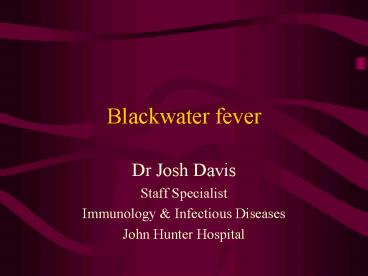Blackwater fever - PowerPoint PPT Presentation
1 / 24
Title: Blackwater fever
1
Blackwater fever
- Dr Josh Davis
- Staff Specialist
- Immunology Infectious Diseases
- John Hunter Hospital
2
Background
- 54 yo married school teacher
- Feltys Syndrome
- Diagnosed 1994. Splenomegaly. RF positive
- RA currently quiescent
- Chronic neutropaenia 2ry to Feltys
- No G-CSF or antibiotics
- Nphils 0.3-0.5 since at least 1998
- GIH in 8/04. Settled spontaneously. Awaiting
upper and lower endoscopies - No Regular Medications
3
Presenting Illness
- Well until 4 hours prior to presentation
- At 1800, crampy abdominal pain, loose stools (no
blood), chills and rigors. - Went to MMH ED
- O/E. T40.1 degrees. Frank haematuria.
Hypotensive 80 systolic. Nil else localising
4
Initial Management
- CXR clear, FBC 103/2.9/244, Bilirubin 153, other
LFTs normal - ? Pyelonephritis in setting of febrile
neutropaenia - Fluid resuscitation, Cefepime, Gentamicin
5
Next 8 Hours
- Haemoglobin plummeted
- Developed respiratory failure with bibasal
crepitations and bilateral new pulmonary
infiltrates - ? Autoimmune haemolytic anaemia
- ?Infection
6
(No Transcript)
7
(No Transcript)
8
(No Transcript)
9
Progress
- Transferred to JHH ICU
- Rapidly developed ARDS, septic shock, DIC
- Intubated, required noradrenaline infusion
- Transfused for massive haemolysis
- Blood cultures flagged positive
10
(No Transcript)
11
(No Transcript)
12
(No Transcript)
13
Day 1
- Presumptive diagnosis Clostridial bacteraemia
with consequent massive haemolysis (Grew
C.perfringens) - CT Abdomen revealed small liver collection
- CT-guided pigtail drain placed in collection
- Nearly exsanguinated into abdomen from liver
puncture. Impossible to ventilate
14
Day 1
- Transferred to OT for laparotomy moribund not
expected to survive - On Nad 0.40mcg/kg/min, Vasopressin, Pressure
Control Ventilation, 80 oxygen. BP 60-70 sys - APTTgt100, PT 46, Fibrinogen 0.2
- 5 litres blood drained from abdomen. Liver packed
15
Blood products first 4 days
- Packed Cells
- 46 units
- FFP
- 34 units
- Cryoprecipitate
- 52 units
- Pooled platelets
- 15 bags
16
Progress
- Survived against all odds
- Developed ARF requiring CVVH then haemodialysis
for 1 month - Discharged from ICU day 18, from hospital 46
- Received 6 weeks IV antibiotics (penicillin
changed to metronidazole because of cholestasis)
for liver abscess - Still awaiting scopes. Has dysphagia . . . . .
17
Clostridial Bacteraemia
- 31/3/05
- Josh Davis
18
Clostridia - Microbiology
- Anaerobic, spore-forming, gram positive rods.
- 90 species exist the most important in humans
are - C tetani Tetanus
- C botulinum Gas gangrene
- C difficile Pseudomembranous colitis
- C perfringens see below
- C septicum bactraemia with colonic Ca.
19
Clostridium perfringens - Microbiology
- Ubiquitous in soil and faeces
- Found in every soil sample ever tested except for
the sands of the sahara - Found in the faeces of every vertebrate species
tested - Originally called C.welchii
- Secretes gt12 exotoxins, most of which are lethal
(to mice)
20
Clostridium perfringens - Microbiology
- Alpha - Toxin
- AKA Lecithinase or Phospholipase C
- Directly destroys RBC membranes, causing
haemolysis - Enterotoxin
- Food poisoning
- Others
- Haemolysins, DNAses, collagenase, protease,
hyaluronidase - Spread through tissue and cause necrosis (gas
gangrene)
21
C.perfringens Clinical Syndromes
- Soft tissue infections
- Simple wound infection (polymicrobial)
- Crepitant cellulitis (does not invade healthy
muscle) - Clostridial myonecrosis (gas gangrene)
- Intraabdominal infections (see irrelevant aside)
- Emphysematous cholecystitis
- Enteritis necroticans
- Typhlitis
- Pelvic infections post-TOP
- Primary bacteraemia
- Food poisoning
- Mild, no treatment required
22
C. Perfringens bacteraemiaCase series Rechner
et al.1
- Rural US hospital all positive blood cultures
1990-1997 - Clostridia were 74 of 63,000 (0.12)
- C.perfringens most common, followed by C.septicum
- 48 had underlying malignancy
- Mortality was 58
- 52 were found to have a GI source
- Only one patient had massive intravascular
haemolysis
1- Rechner et al. CID 2001 33 349-53
23
Massive haemolysis associated with C.perfringens
bacteraemia
- Literature review 1999, Alvarez et al.1
- 19 cases in entire world literature
- 11/13 rapidly fatal (85 mortality)
- Mean time from diagnosis to death8 hours
1 Alvarez et al. Massive hemolysis in
Clostridium perfringens infection Haematologica.
1999 Jun84(6)571-3.
24
C.perfringens bacteremia - summary
- 1) Rare (approx 0.1 of bacteraemias)
- 2) Usually associated with underlying malignancy
or debility - 3) Usual primary source is colonic lesion
- 4) High mortality 40-60
- 5) TreatmentPenicillin, debridement
- 6) Massive haemolysis very rare and almost always
fatal within hours.

